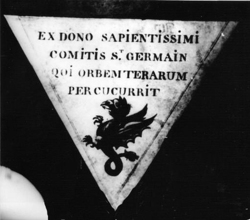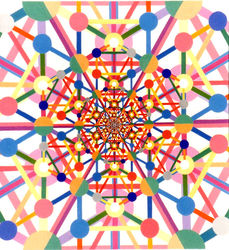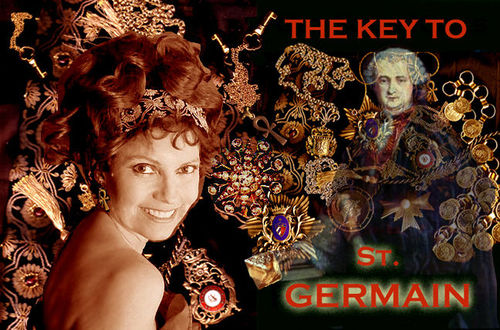Alchemy Defined
The Philosophy of Alchemy
Alchemy is the quest for an agent of material perfection, produced
through a creative activity (opus), in which humans and nature
collaborate. It exists in many cultures (China, India, Islam; in the
Western world since Hellenistic times) under different
specifications: aiming at the production of gold and/or other
perfect substances from baser ones, or of the elixir that prolongs
life, or even of life itself. Because of its purpose, the alchemists’
quest is always strictly linked to the religious doctrine of redemption
current in each civilization where alchemy is practised.
In the Western world alchemy presented itself at its advent as a
sacred art. But when, after a long detour via Byzantium and Islamic
culture, it came back again to Europe in the twelfth century, adepts
designated themselves philosophers. Since then alchemy has
confronted natural philosophy for several centuries.
In contemporary thought the memory of alchemy was scarcely
regarded, save as protochemistry or as a branch of esotericism,
until interest in it was revived by C.G. Jung. Recent research is
increasingly showing the complexity of alchemy and its multiple
relation to Western thought.
1 Name and definition
The name ‘alchemy’ appeared in Islamic culture, whence it passed to
Latin. It evolved (apparently) from the Greek ‘chemèia’ (art of melting
metals) or ‘chymos’ (juice). An alternative etymology, supported by the
Hermetic tradition, indicates ‘kemi’ (black clay), the ancient name of
Egypt, pointing to the mythological link with the god Hermes-Thoth.
Initially alchemy denoted both the art and its product; this latter use,
however, is rare in the Western tradition. As a name indicating the art or
opus, its meaning varies depending on the period referred to: originally it
designated the practical and theoretical search for transmutation,
whereas in contemporary esotericism it indicates the concrete
achievement(s) associated with a pre-eminently spiritual quest.
Accordingly, the decision about what is an alchemical text or an
alchemical image may differ: we distinguish a historical, an esoteric and
a psychological approach. Historians consider written tradition
(manuscript and printed texts and images) the one and only testimony of
a doctrine evolving in time. For esotericists, this same tradition is nothing
but the surface of a secret, immutable knowledge, often deliberately
disguising its truth. For depth psychology alchemy encompasses virtually
every kind of symbolic production.
The definition given by H.J. Sheppard (1986), currently the most widely
accepted, takes into account all approaches: ‘ Alchemy is the art of
liberating parts of the Cosmos from temporal existence and achieving
perfection which, for metals, is gold, and for man, longevity, then
immortality and, finally, redemption’.
2 Epistemological structure
The association of practice and theory characterizes alchemy from its
very beginning and distinguishes it from other symbolic lore. Archaic
metallurgy, in its connection with religious rites, is generally considered
the cradle of alchemy: this opinion has accounted for the religious and
even mystical elements in alchemy since the work of Zosimus of
Panopolis (c.3-4 AD). Yet the earliest acknowledged alchemical text
(Bolus of Mende, pseud. Democritus, Physikà kai mystikà c.1 AD)
shows that just those metallurgical practices imbued with religious
significance were the basis on which a theory of matter was beginning to
be built: a theory derived from practice, not the contrary.
Indeed, the dependence of theory on practice marks the whole history of
alchemy. For its theoretical content, Western alchemy was called ‘the
child of Greek philosophy’, but we cannot accept such a genealogy
without remembering that there was also another ‘parent’, namely,
concrete work on matter. In the Middle Ages, as practical alchemy
interacted with the development of techniques and craftmanships
(metallurgy, goldsmith, dyeing, pharmacology), it was first considered an
‘ars mechanica’, but soon its theoretical meaning became clear to
philosophers like Albert the Great and Roger Bacon, and the close
connection between alchemical practice and religious-philosophical
speculation continued with Paracelsus and the Rosicrucians, with
Newton and Goethe (see Paracelsus §3).
Therefore we cannot speak of alchemy proper where we find only a
practice, be it metallurgy, distillation or whatever else: the dyeing recipes
of medieval painters, or distillation among Renaissance physicians.
However, we must be equally careful not to speak of alchemy too
readily whenever alchemical symbolism is used for other purposes: for
example, by mystics.
The connection between practice and theory accounts for, and delimits,
the contribution of alchemy to the birth of chemistry. Like ancient artisans, who owned secret
techniques transmitted through apprenticeship, alchemists were secretely
initiated to the opus. The secrecy of alchemy is a major point of
divergence from chemistry, which, like all modern sciences, is
characterized by public discussion and teaching. Moreover, although
alchemists for centuries worked with metals and minerals, invented
techniques (for example, distillation), designed and used laboratory
apparatus that chemists would inherit, they never relinquished their
original religious attitude; as a consequence of this, theoretical
developments were radically different from those of modern chemistry.
Basically, for alchemists, matter was no inert object but the body of their
own Mother Nature. So there is no epistemological continuity between
alchemy and chemistry; protochemical features may be disentangled only
a posteriori from a doctrinal whole owing its orientation to totally
different ideas and purposes.
3 Features of the alchemical literature
The initiatory character of alchemical teaching accounts for the most
striking feature of the language of alchemists, that is, the use of a rich
symbolism. Metaphorical names for substances and processes were
used from the beginning, an attitude reinforced by Arab alchemists and
complicated by the obvious difficulties of Latin translators. The use of
metaphors met the need for secrecy and facilitated the merging of
operative and religious meaning; but it also prevented the creation of a
technical vocabulary (another major difference from chemistry) and
fostered the transformation of alchemy into an occult art.
This retreat into the occult, accompanied by the development of
alchemical imagery, began at the end of the Middle Ages, when
metallurgical alchemy was defeated by the denunciation of alchemists as
forgers and the idea of the medical elixir began to be associated with the
prophetic and visionary mood of the Spirituals. So, while many medieval
texts were written in a clear language and even, sometimes, in a truly
philosophical style, the number of obscure writings playing with symbols
and visions increased steadily from the fourteenth century. Later
alchemists went further, explicitly linking their art to ancient mythology
and eventually wholly replacing words with images.
Thus the main difference inside alchemical literature is between clear
and obscure texts. Various genera belong to the first group: recipes,
practical treatises, theory and practice texts, commentaries, veritable
summae; rarely does their ‘clear’ character match our modern demands
for clarity. Obscure texts comprise mainly visions, riddles, and poems.
A relevant feature of the alchemical literature, since its very origin, is its
pseudoepigraphical character, often connected to the creation of legends
concerning the supposed authors of alchemical writings. By means of
pseudoepigraphy alchemists clearly attempted to enrol themselves in the
philosophical tradition, albeit awkwardly. Texts were attributed to pagan
gods, mythological and biblical figures, ancient and medieval
philosophers. Such attributions assured secrecy, while raising the prestige
of writings of obscure authors; they might even be a subtle indication of
affiliation.
4 Alchemical doctrines
The basic idea of alchemy is the identity of nature and first matter as a
dynamic unity: elements can pass one into another, in a circular
movement that alchemists reproduced in their vessels. No theory of
natural loci (low and high are interchangeable, according to the Tabula
smaragdina c.9 AD), no dualism of matter and spirit exists, as first
matter is the all-embracing source of change. The alchemist, who can
obtain first matter by means of the dissolution of natural bodies, is almost
a new creator who makes a new reality come out of the artificially
produced chaos ‘putting nature into nature’, that is, cultivating the seeds
of perfection existing in nature (perfect metals) according to natural
rules, and ‘awaiting nature’s time of delivery’. (R. Llull, Testamentum
c.14 AD).
This structure is first seen as continuity inside the inanimate field of
metals, and as analogy between metals and planets: all metals are
nothing but imperfect gold (like embryos at various stages), and the
alchemist accomplishes nature’s work outside the womb of earth in a
shortened time, possibly within an astrological framework. Some
alchemists viewed the process as a victory over nature and time,
foreshadowing the Promethean developments of modern science and
technology: there are some hints that medieval theologians rebuked
alchemy for this claim. Yet the relation between alchemical art and
nature’s work was generally considered in a more subtle and complex
way, especially in the theoretical attempts made by fourteenth-century
alchemists who developed the idea of elixir. Continuity from inanimate
matter to human beings was explicitly or implicitly affirmed, and the
alchemists were conscious of themselves as a part of the matter/nature
that they manipulated in order to perfect, not to dominate. This
consciousness preserved their attitude of religious reverence for nature,
whose abandonment was a major feature of modern science.
5 Alchemy and Western philosophy
Discussing matter and its transformations, alchemists encountered
philosophical themes from the beginning. There have even been attempts
to trace back alchemy to Aristotle’s idea of change in material
substances (see Matter §1), but actually alchemy (practice plus theory)
was not yet born. In later Antiquity an especial relationship existed
between alchemy and Hermetic thought (see Hermetism): the unity of
first matter, the principle of sympathy, the doctrine of occult virtues, all
are behind Bolus’ axiom that ‘Nature is charmed by nature, nature
prevails over nature, nature rules nature’. The Stoic doctrine of pneuma
lingers on in the search for material essences through distillation, a
practice that goes back to Maria the Jewess (c.3 AD) (see Stoicism §4).
Medieval developments were considerable, as scholastic philosophers
and alchemists compared alchemy to the Aristotelian philosophical
concepts. According to Albert the Great (De mineralibus c.13 AD)
alchemy helped to complete the Aristotelian science of metals. Roger
Bacon showed a broader concern, viewing alchemy as the general
theory of generation and corruption of all natural beings. Some
alchemists even tried to translate into Aristotelian language their
experience, identifying form with the purest and thinnest substance
(quintessence) resulting from sublimation or distillation. How much of
Stoic natural philosophy intermingled with Aristotelian ideas in this
attempt is unclear. Form was also identified with the soul, so that all
material bodies, metals included, were considered endowed with a soul;
body and soul were kept united by spirit, an idea which the alchemists
could also find in medical literature, and developed into that of the
universal ‘medium’ that gives unity and life to the created world.
The Hermetic elements had never disappeared from Western alchemy,
as the central role of the Tabula smaragdina shows; during the
Renaissance, they became prevalent. Alchemical doctrines were known
to virtually every Renaissance philosopher, discussed by most of them,
accepted by many. The relation between Renaissance Platonism and
alchemical thought might be considered afresh, as alchemy is a project to
obtain on earth the stability and perfection that characterize the Platonic
world of ideas, manipulating the universal spirit that mediates between
matter and the divine world. The most significant development, however,
can be found in Paracelsus, whose idea of ‘making visible the
invisible’ rests on the alchemical assumption that the quintessence of
material bodies can be revealed through the opus. So, Paracelsian
alchemy aimed at revealing the secret of life and putting it to work for
the spiritual and bodily health of humans. More definitely, the idea of an
alchemical remedy or elixir crystallized in that of potable gold, which
interested Ficino and Francis Bacon among others.
In the seventeenth century, Francis Mercurius van Helmont turned the
idea of the universal spirit into that of alkahest, the basis for subsequent
chemical developments which ultimately led to the discovery of oxygen.
Newton’s alchemical and cosmological speculation about the creative,
non-mechanical spirit animating matter is at the core of the debate about
the role of Hermetism in the Scientific Revolution. The re-emergence of
Stoic ideas concerning first matter and mixed bodies in
seventeenth-century alchemy has recently been considered to establish it
as part of the normal science of that epoch. Even after the birth of
modern chemistry, alchemy maintained its appeal to speculative spirits:
Goethe apart, we have the clear instance of the subsequent development
of Naturphilosophie in nineteenth-century Germany (see
Naturphilosophie), with alchemical doctrines flowing into the mainstream
of vitalism (see Vitalism). More surprising perhaps is to find alchemy
defined in the Encyclopédie as chemistry brought to the highest degree
of perfection and therefore capable of operating marvellous effects, ‘la
chimie sublime, la chimie par excellence’.
6 Alchemy and the present
Nineteenth-century scholarly research on protochemistry overlapped
with the latest development of esoterical alchemy (hyperchemistry).
Historians of chemistry judged alchemy a mix of positive empirical data
about chemical matter with obscure mystical speculation. An echo of
their attitude is still felt in the consideration of alchemy as an error in the
history of science, indeed, according to Bachelard, ‘the first error’ in the
scientific approach to the problem of matter.
Alchemy attracted the attention of C.G. Jung as a historical testimony of
the dynamics of the unconscious. Jung’s deep study of alchemy led him
first to conceive of it as the projection upon matter of the unconscious
tendency to individuation; but he also saw in alchemy the expression of a
more complex relation between humanity and nature, where matter is
recognized as the feminine counterpart of the divine, and human
knowledge is fostered by the very light of nature (a Paracelsian idea),
comparable to the light of Revelation. Thus Jung gave a positive value to
the link between religious attitude and empirical research in alchemy. On
the other hand, the idea of the alchemists as forerunners of the modern
ideal of the scientist who overcomes nature and time is at the core of M.
Eliade’s (1956) view of alchemy as an intermediate stage between
archaic metallurgy and modern technology.
Recent proposals from within French esotericism bear on epistemology
and aesthetics: A. Faivre’s (1971a) conception of the non-dualistic logic
of alchemy links it to the most advanced results in the epistemology of
physics, while F. Bonardel (1993) defines the alchemist’s attitude as
taking charge of the created world. She opposes the
Promethean-Faustian view of alchemy, and deplores its gradual fall from
the original position of the art of Hermes, proposing its identification with
poetry. Another contemporary way of stressing the Hermetic meaning of
alchemy is that of focusing on its figurative symbolism, not only in the
images linked to alchemical texts or in the alchemical interpretation of
artists of the past, but even in defining the creative process of
contemporary art as alchemy.
MICHELA PEREIRA
Routledge Encyclopedia of Philosophy, Version 1.0, London: Routledge
Sample Photo 1
Sample Photo 2
Sample Photo 3
Sample Photo 4

Sample Photo 5

Sample Photo 6





